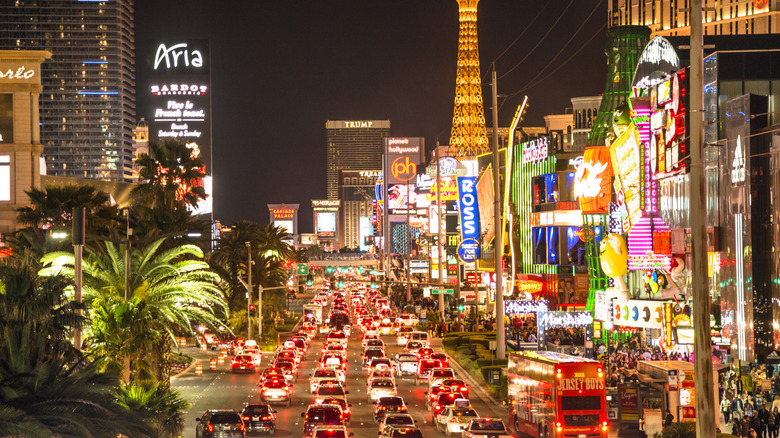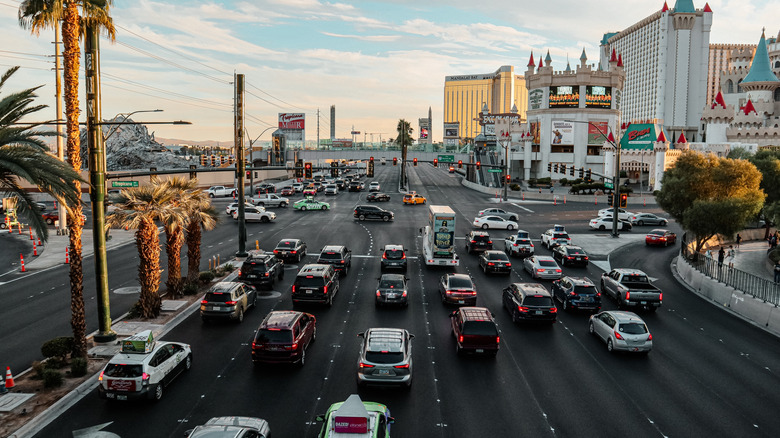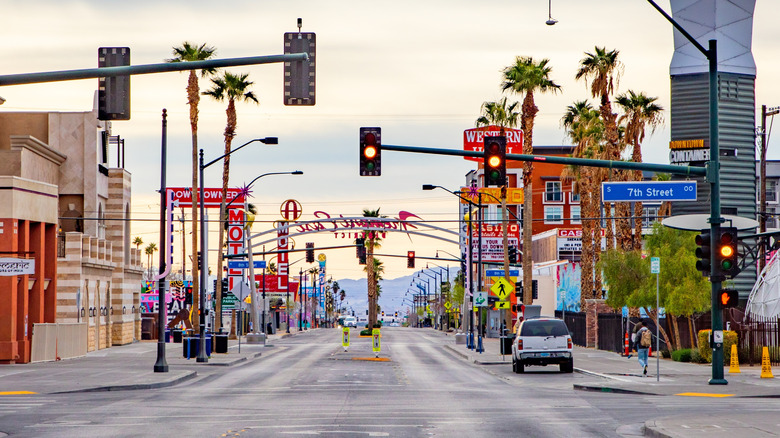Why Do Traffic Lights Take So Long In Las Vegas?
There's nothing worse than driving in traffic while commuting to work — except sitting at a long stoplight during that commute, of course. The duration of a stoplight varies from state to state, town to town, even intersection to intersection — and some are much longer waits than others. There's an infamous traffic light in New Jersey that is red for 57 minutes each hour, staying red for 2 minutes, 15 seconds, and going green for only 8 seconds repeatedly. But there's one city in the United States that's known for having long stoplights all over the place — Las Vegas, Nevada.
Las Vegas can test the most patient and experienced of drivers — even Waymo cars have been sent there as a proving ground to see if the autonomous vehicles are ready to take on complex layouts. The traffic congestion is considered some of the worst in the country, and the confusing layouts around the Strip have made plenty of roads in the city dangerous. Add in some long traffic lights, and Las Vegas is not a great destination for anyone with road rage.
While it can seem like simply a source of frustration and torture, the long traffic lights are there for a reason. Las Vegas' large intersections and massive amounts of tourists have made the city's stoplights excruciating for commuters.
Why are Las Vegas stoplights so long?
There are 1,600 traffic lights in southern Nevada, and not all are equally painful in length. However, the ones located in Las Vegas have caused so much frustration that drivers have started making dangerous moves to escape the wait. The main reason is that Las Vegas is full of large intersections to accommodate all the traffic — both vehicle and on-foot — caused by tourism, which can be over 4.5 million people a year. These massive intersections sometimes have multiple left, through, and right lanes. This means there are a lot of cars and large waves of pedestrians crossing wide streets in all directions. On some intersections with six lanes, it can take pedestrians 120 seconds or more to get across the walkway.
According to Theresa Gaisser, the Senior Director of FAST, a division of the Regional Transportation Commission of Southern Nevada, the traffic lights change red light duration throughout the day. That's because the agency factors in the volume of traffic and the amount of pedestrian movement during various times. The lights even have sensors that can react to real-time changes in activity. "During congested periods of the day, there's usually a queue of vehicles, so that's when we are running signal timing to optimize how much of that queue is going to be able to clear every single time," Gaisser said to KTNV Las Vegas
How long are the traffic lights in Las Vegas?
Traffic lights in Las Vegas are all on the same system cycle length in order to remain coordinated with one another — and that cycle length is 120 to 180 seconds. Gaisser didn't share the specific times that each Las Vegas traffic light remains red during that cycle. That's likely because it varies depending on which intersection and time of day — and those stoplight times could change at a moment's notice depending on intersection activity. Gaisser also noted that over 400 traffic signals have been re-timed recently to reduce wait periods, adding another variable — hopefully a positive one.
That hasn't stopped Las Vegas residents from sharing their own horror stories with Las Vegas traffic lights, however. One driver claimed to wait 3 minutes and 15 seconds for a full cycle at the intersection between St. Rose Parkway and East Starr Avenue. Others agreed, noting that the left turn signal portion of the cycle is so short that they've gotten stuck there for up to 12 minutes, waiting over multiple cycles to break free. There are plenty of other intersections that have led to waits nearing seven to nine minutes, with backed up traffic causing them to sit through multiple cycles all around Las Vegas. With so much high-end tech all over the city, hopefully the traffic light system can also continue to see improvements.


